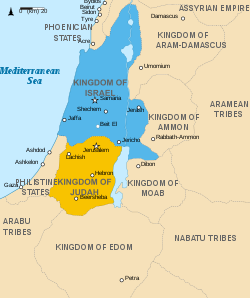Rehaboam
Rehoboam ( Hebrew רְחַבְעָם) ruled as the first king of the Kingdom of Judah during the Iron Age in the eastern Mediterranean from 931 to 914 BC. Chr.

Biblical testimony
His father was King Solomon , his mother the Ammonite Naama . After Solomon's death he did not succeed in preserving the great empire founded by King David according to the Bible . Except for his own tribe of Judah and the tribe of Benjamin , all the tribes fell away from the Davidic royal house and Jeroboam I was elected king of the northern kingdom of Israel .
According to 1 Kings 12, on a prophetic word, Rehoboam abandoned the plan to retake the northern kingdom through war. In addition, idols were worshiped under Rehoboam. His subjects made "heights, stone marks and pictures of ashes " on all high hills and under green trees ( 1 Kings 14.23 EU ). In the fifth year of his reign, the southern kingdom of Judah was attacked by Egypt under the pharaoh Shishak , who is generally equated with Sheschonq I, and parts of the temple treasures were plundered. According to the Bible, a punishment from God.
"In the fifth year of King Rehoboam, Shishak, king of Egypt, went up to Jerusalem and took the treasures from the house of the Lord and from the house of the king, everything that was to be taken."
Rehoboam's son was King Abijah , who ruled for only three years ( 1 Chr 3.10 EU ); his grandson was King Asa , who ruled for 41 years.
archeology
A temple relief of Pharaoh Scheschonq I, 22nd Dynasty ( Third Intermediate Period ), depicting a conquest of Canaan , was found in Karnak , in the great pillared hall of the Amun Temple . The Egyptian chronology refers to the campaign in which Sheshonq is mentioned as Shishak in the Old Testament in connection with Rehoboam's fifth year of reign.
However, it is uncertain whether the cities of Judah were destroyed in the process, since precisely these places, including Jerusalem , are not mentioned on the relief. It is also not yet possible to determine exactly whether the campaign or campaigns took place during the reign of Rehoboam. There is also a hieroglyphic inscription on a stele north of Jerusalem from the Sheschonq campaign, as well as in Megiddo .
After that mainly the cities of the northern kingdom of Jeroboam , u. a. the old tribal area of King Saul was destroyed and the mighty cities of the fertile Jezreel plain were subjected.

literature
- Israel Finkelstein , Neil A. Silberman: David and Solomon. Archaeologists decipher a myth. CH Beck, Munich 2006, ISBN 3-406-54676-5 .
- Markus Lesinski: Rehoboam. In: Biographisch-Bibliographisches Kirchenlexikon (BBKL). Volume 7, Bautz, Herzberg 1994, ISBN 3-88309-048-4 , Sp. 1487-1497.
| predecessor | Office | successor |
|---|---|---|
| Solomon |
King of Judah approx. 931–914 BC Chr. |
Abija |
| personal data | |
|---|---|
| SURNAME | Rehaboam |
| BRIEF DESCRIPTION | King of Judah |
| DATE OF BIRTH | 966 BC Chr. |
| PLACE OF BIRTH | unsure: Jerusalem |
| DATE OF DEATH | 910 BC Chr. |